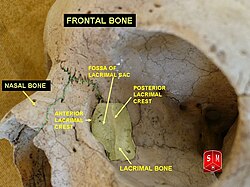Lacrimal bone
| Lacrimal bone | |
|---|---|

Position of the lacrimal bone (shown in green).
|
|

Medial wall of the orbit. Lacrimal bone is in yellow.
|
|
| Details | |
| Identifiers | |
| Latin | os lacrimale |
| TA | A02.1.09.001 |
| FMA | 52741 |
|
Anatomical terms of bone
[]
|
|
The lacrimal bone is the smallest and most fragile bone of the face; roughly the size of the little fingernail. It is situated at the front part of the medial wall of the orbit. It has two surfaces and four borders. Several bony landmarks of the lacrimal bone function in the process of lacrimation or crying. Specifically, the lacrimal bone helps form the nasolacrimal canal necessary for tear translocation. A depression on the anterior inferior portion of the bone, the lacrimal fossa, houses the membranous lacrimal sac. Tears or lacrimal fluid, from the lacrimal glands, collect in this sac during excessive lacrimation. The fluid then flows through the nasolacrimal duct and into the nasopharynx. This drainage results in what is commonly referred to a runny nose during excessive crying or tear production. Injury or fracture of the lacrimal bone can result in posttraumatic obstruction of the lacrimal pathways.
The lateral or orbital surface is divided by a vertical ridge, the posterior lacrimal crest, into two parts.
In front of this crest is a longitudinal groove, the lacrimal sulcus (sulcus lacrimalis), the inner margin of which unites with the frontal process of the maxilla, and the lacrimal fossa is thus completed. The upper part of this fossa lodges the lacrimal sac, the lower part, the nasolacrimal duct.
The portion behind the crest is smooth, and forms part of the medial wall of the orbit.
The crest, with a part of the orbital surface immediately behind it, gives origin to the lacrimal part of the Orbicularis oculi and ends below in a small, hook-like projection, the lacrimal hamulus, which articulates with the lacrimal tubercle of the maxilla, and completes the upper orifice of the nasolacrimal canal; the hamulus sometimes exists as a separate piece, and is then called the lesser lacrimal bone.
The medial or nasal surface presents a longitudinal furrow, corresponding to the crest on the lateral surface.
...
Wikipedia
